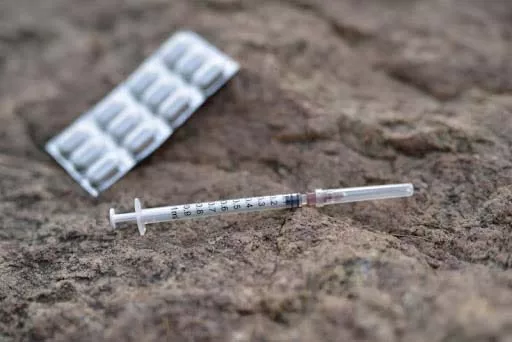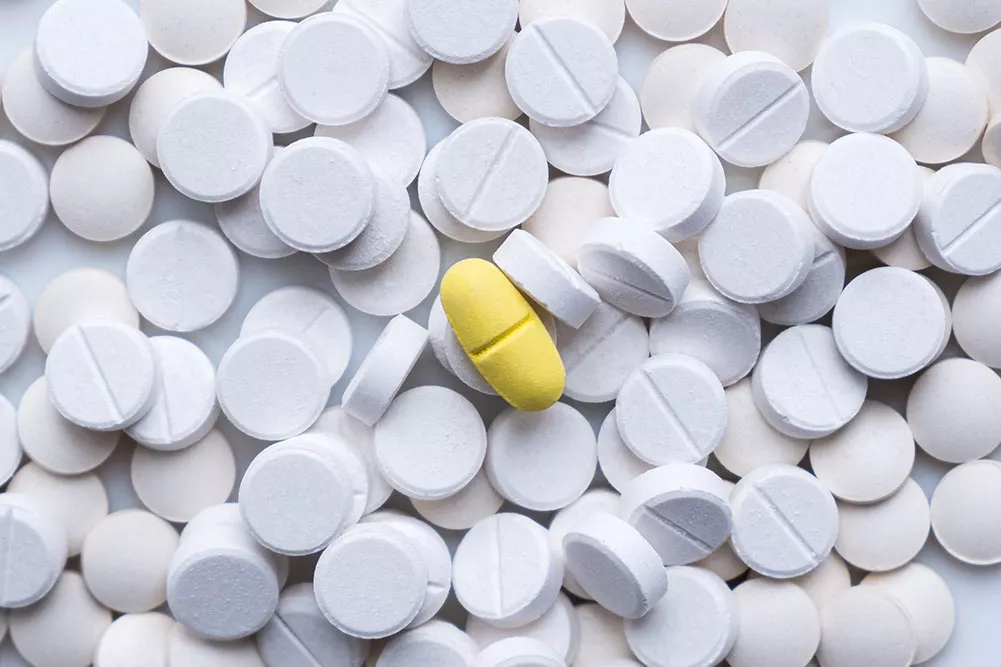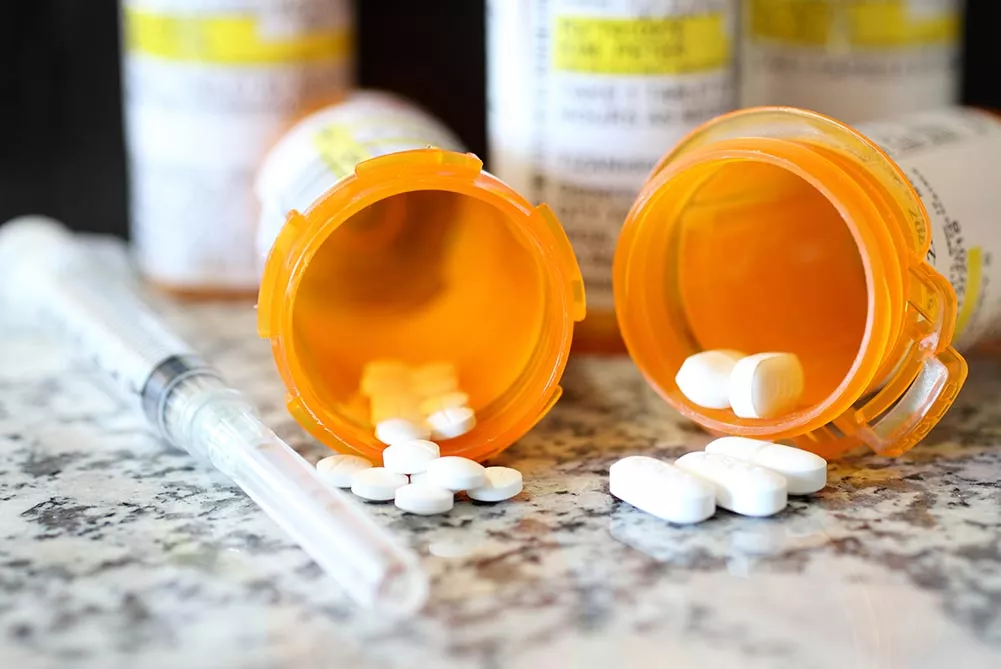Naltrexone, sold under brand names such as ReVia, Vivitrol, and Depade, is a medication for opioid dependence and alcohol dependence. As a medication-assisted treatment (MAT), Naltrexone was initially approved by the U.S. Food and Drug Administration (FDA) in 1984 to treat opioid addictions such as heroin, morphine, and oxycodone. And it was later approved for treating alcohol use disorder in 1994.
Naltrexone is available as a daily dose in a pill form (ReVia and Depade) or as a monthly intramuscular injection (Vivitrol) for treating alcohol and opioid use disorders. Naltrexone is considered unique to other substance use disorder medications because it treats both opioid and alcohol use disorders. When used in combination with behavioral therapy, counseling, and aftercare support, naltrexone is a highly effective medication.
Naltrexone belongs to a class of medications known as opioid antagonists. This medication delivers powerful opioid-blocking effects through both oral naltrexone and injectable naltrexone options. Naltrexone works by blocking the sedative and intoxicating effects of opioids by binding to the endorphin receptors in the body and blocking opioid receptors in the brain. This function, combined with behavioral health therapies like cognitive behavioral therapy, helps maintain abstinence and prolong recovery. Naltrexone is effective in substance use disorder maintenance treatment because it’s a non-narcotic medication with a low risk of misuse. Naltrexone can be prescribed and administered by any practitioner licensed to prescribe medications since it is not a controlled medication.
Individuals must remain opioid-free for at least seven days after their last use of short-acting opioids and 10-14 days after their last use of long-acting opioids before initiating naltrexone treatment to lessen the risk of rapid opioid withdrawal syndrome. Naltrexone can be prescribed to those who are currently using alcohol. While naltrexone does not necessarily stop you from drinking or reverse the intoxicating effects of alcohol, it does gradually reduce the amount that you drink. However, it may take many weeks after starting naltrexone to notice a reduction in opioid or alcohol cravings.
Oral naltrexone absorbs quickly and begins to work within an hour after consumption. The effects of the 50-mg oral tablet can last for 24 to 36 hours. The duration of higher doses is longer lasting, with 100 mg lasting 48 hours and 150 mg lasting 72 hours. Naltrexone usually reaches its peak within one hour of dosing.
The dosing of intramuscular extended-release naltrexone (Vivitrol) is 380 mg given as a monthly injection. Vivitrol reaches its initial peak around two hours after administration, followed by a second peak within two to three days. Two weeks after administration, the medication’s concentration in the body begins to decline. It can, however, be detected for up to 50 days after initial administration.
In addition to its beneficial effects, naltrexone can also cause certain negative effects. However, the majority of these side effects are minor and fade away with time.
Common side effects of naltrexone include:
Naltrexone can cause severe side effects in rare circumstances. These side effects may include:
Medical professionals advise that you discuss the following conditions with your healthcare provider before starting naltrexone treatment to lessen the chance of side effects. These conditions include:
Your healthcare practitioner can determine the safest dose of naltrexone or recommend an alternative medicine based on these conditions.
Determining exactly how long naltrexone is detectable in your body depends on many variables. These variables include the form of naltrexone taken and the type of drug tests being utilized.
The timetable for detecting naltrexone in the body also depends upon factors such as:
These variables make it almost impossible to determine an exact time at which naltrexone will show up on blood tests or other drug screening methods. However, naltrexone is usually detected in the urine within the first four to six hours following administration and for up to 24 hours in the blood and saliva. And it can also be detected in the hair for up to 90 days. Vivitrol, on the other hand, can remain detectable in drug tests for months.
Typically, for a drug test to detect a certain substance, that substance must be specifically tested. And naltrexone is not generally included in any of the typical testing panels.
Naltrexone may interact with other medications, resulting in severe side effects. Since this medication is used to treat alcohol and opioid addiction, individuals on naltrexone must avoid certain medications to prevent unpleasant withdrawal symptoms. Before starting naltrexone, inform your healthcare provider of any other medications you’re taking, including over-the-counter medicines and herbal remedies.
Medications that interact negatively with naltrexone include:
It’s theoretically possible to overdose while on naltrexone if a person takes large amounts of opioids or alcohol in an attempt to counteract the effects of naltrexone or in case of a relapse after a period of maintained abstinence.
Signs and symptoms of an overdose include:
Opioid overdose is a medical emergency that requires immediate medical attention.
Successful treatment programs typically combine pharmacologic interventions like naltrexone’s extended-release formula with relapse prevention strategies and ongoing support. This comprehensive approach, especially when paired with behavioral health therapies, has shown significant success in maintaining long-term recovery.
Naltrexone is a non-narcotic medication with a low risk of side effects. However, naltrexone works best when combined with other aspects of SUD treatment, such as behavioral therapy, counseling, and aftercare support.
If you are seeking help with your loved one’s addiction, contact us today or complete our quick contact form below, to speak with an addiction treatment specialist.
If you need help with your substance use disorder, we are here to help you build your confidence and momentum towards the future you want. We provide treatment services for adults with alcohol, opioid, and other substance use disorders. We are currently located in Louisiana, Massachusetts, New Jersey, North Carolina, Ohio, Texas, and Washington.
 Naltrexone Implant – How Can it Help You?
Naltrexone Implant – How Can it Help You?
 Naltrexone Uses in Addiction Treatment
Naltrexone Uses in Addiction Treatment
 Naltrexone vs. Suboxone – How are They Different?
Naltrexone vs. Suboxone – How are They Different?